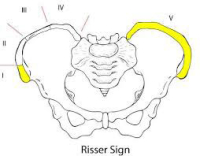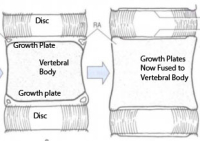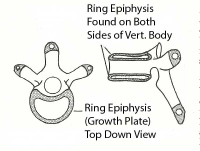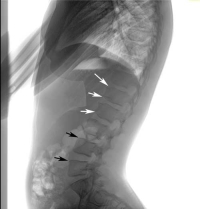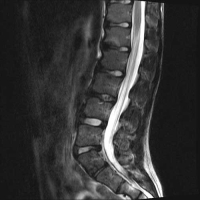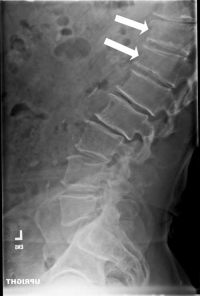An Overview of
This condition was first described in 1921 by Holger Werfel Scheuermann, a Danish surgeon, as an “osteochondrosis”. To understand thoraco-lumbar Scheuermann’s disorder, you have to understand how the vertebral bodies form and develop as the onset of this condition occurs when the patient is an adolescent (from ages 8-15). This problem is considered a genetic disorder.
The vertebral body enlarges through growth plates. These are cartilaginous rings on the top and the bottom of the vertebral body like plastic caps on either end of a can. The cartilaginous rings expand and form bone (cartilage is the precursor to bone). The vertebral body continues to thicken and when fully grown, these rings fuse to the body and become one solid piece of bone. The fusion of these rings occurs generally around the ages of 18-22 even though the bone growth has stopped by about 15 years of age.
There is increased pressure on the front of the vertebra due to the normal alignment of the spine, especially when bending over. For some reason that has yet to be determined, some individuals develop “softer” growth plates on these vertebral bodies in a condition called osteochondrosis. This increased pressure causes injury to the growth plate in front and deforms the vertebra.
In thoraco-lumbar Scheuermann’s disorder, the anterior growth plates (the front of the vertebra) will fragment and sometimes disappear due to this pressure. This means that while the growth plates in the middle and rear of the vertebra continue to grow, the plates in front stop growing. With this mismatch in growth, the vertebra grows into a wedge instead of a barrel shape creating an abnormal forward angulation called a kyphosis. The normal curve is a backwards curve called a lordosis.
This abnormal curve (the kyphosis) then adds insult to injury. The curve actually increases the load on the front of the spine and creates further overload of the vertebra which in turn worsens the situation similar to a snowball rolling downhill getting bigger the further it rolls.
When the patient with this disorder cause impact to his or her spine (as in landing from a jump), it is not uncommon to have a fracture of the endplate of the vertebra occur. Since the endplate is soft, the jelly in the center of the disc pushes on the endplate and this force produces the fracture. The center jelly actually pushes (herniates) into this cavity which is called a Schmorl’s node.
If thoraco-lumbar Scheuermann’s disorder can be diagnosed when the adolescent is still young and still has growth left, the spine can be unloaded by using a brace. With the pressure in front reduced by the brace, the growth rings in front may heal, filling in the defect and preventing the kyphosis.
If not caught in time, this is not the end of the world as thoraco-lumbar Scheuermann’s disorder can “burn out”. The typical scenario is a young man of 19 who has had pain the thoraco-lumbar spine for years and finally, the pain diminishes as the growth plates heal in. The residuals of wedged vertebra and degenerative discs will still be present but these changes may be asymptomatic (not pain producing). However, a significant percentage of individuals who have residual deformity from thoraco-lumbar Scheuermann’s disorder may have thoraco-lumbar pain throughout the rest of their life.
Are you suffering from symptoms of Thoraco-Lumbar Scheuermann’s Disorder?
Would you like to consult with Dr. Corenman about your condition?
You can set up a long distance consultation to discuss your
current X-rays and/or MRIs for a clinical case review.
(Please keep reading below for more information on this condition.)
Conservative Treatment of
If the diagnosis is made when there is still growth possible, the patient can be placed in a thoraco-lumbar extension orthosis (TLSO) to unload the front of the spine. The brace needs to be worn when upright for most of the day. Certain exercises can be encouraged (swimming for example) that involve extension (bending backwards). Contact sports and sports that include flexion (cycling for example) should be avoided. Extension stretching and strengthening exercises should be encouraged (strengthening while in the brace, stretching out of the brace).
If the diagnosis is made after the growth plates have healed in, bracing is not helpful. A corset might be pain relieving but should not be worn full time. Again extension exercises are very helpful to condition and strengthen the muscles. These exercises will not correct the curve but will allow the paravertebral muscles to contract “like a guy-wire” to reduce the stress on these painful segments. Chiropractic manipulation can be pain relieving also.
If thoraco-lumbar Scheuermann’s disorder becomes too painful or the kyphosis angulation is greater than 25 degrees, surgery can be contemplated.
To learn more about
Related Content
- Sacroiliac Joint Pain Syndrome
- Spinal Cord Injuries
- Stress Fractures of the Lower Extremities
- Scoliosis
- Thoraco-Lumbar Scheuermann’s Disorder
- Thoraco-Lumbar Spine Fractures
- When to Have Lower Back Surgery
- Causes of Lower Back Pain
- Normal Spinal Alignment
- How to Describe Your History and Symptoms of Lower Back and Leg Pain
- Best Questions to Ask When Interviewing a Spine Surgeon or Neurosurgeon

